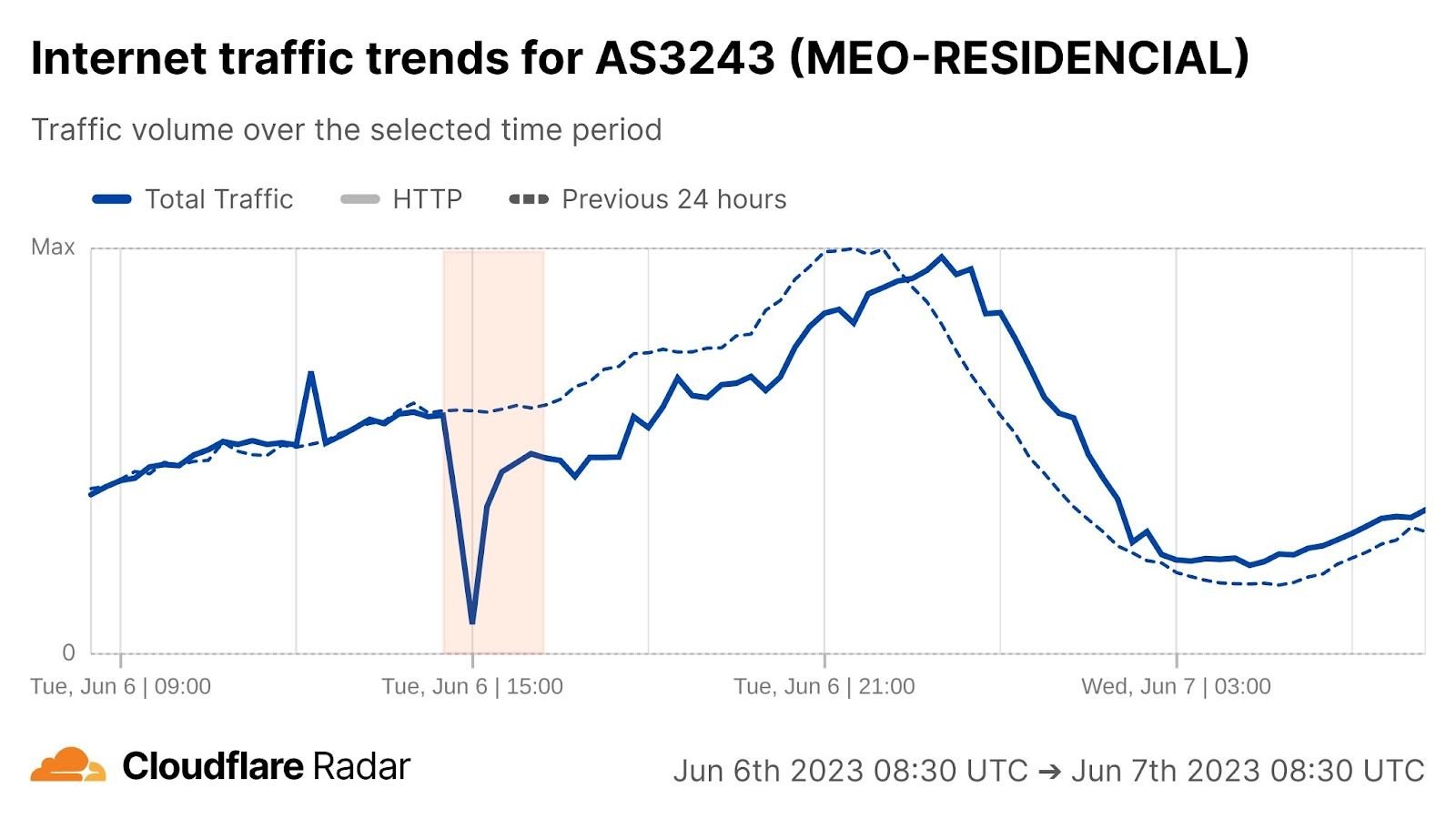Loading...
This post is also available in Deutsch, Français, 日本語.
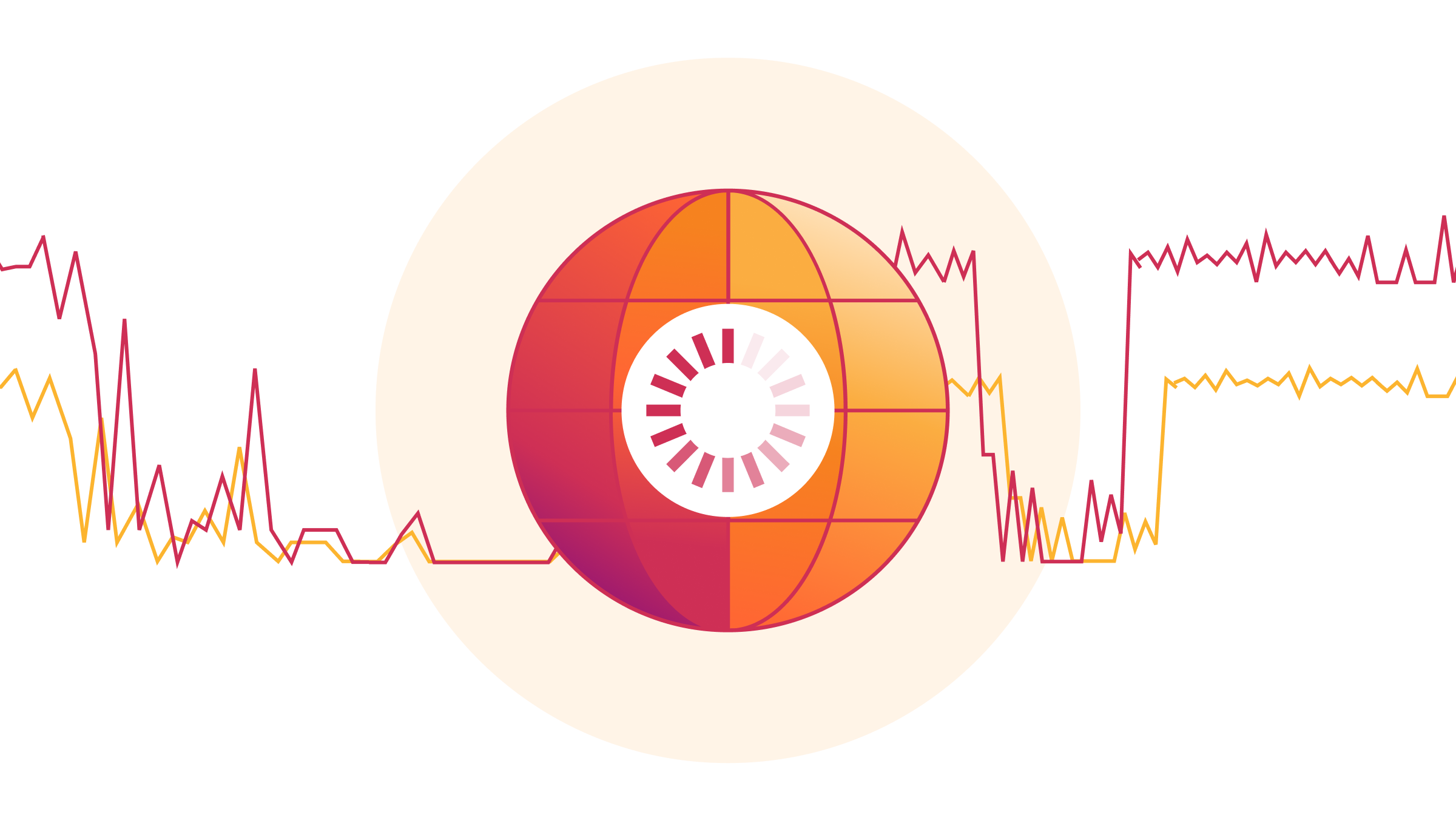
Cloudflare operates in more than 300 cities in over 100 countries, where we interconnect with over 12,000 network providers in order to provide a broad range of services to millions of customers. The breadth of both our network and our customer base provides us with a unique perspective on Internet resilience, enabling us to observe the impact of Internet disruptions.
The second quarter of 2023 was a particularly busy one for Internet disruptions, and especially for government-directed Internet shutdowns. During the quarter, we observed many brief disruptions, but also quite a few long-lived ones. In addition to the government-directed Internet shutdowns, we also observed partial or complete outages due to severe weather, cable damage, power outages, general or unspecified technical problems, cyberattacks, military action, and infrastructure maintenance.
As we have noted in the past, this post is intended as a summary overview of observed disruptions, and is not an exhaustive or complete list of issues that have occurred during the quarter.
Government directed
Late spring often marks the start of a so-called “exam season” in several Middle Eastern and African countries, where students sit for a series of secondary school exams. In an attempt to prevent cheating on these exams, governments in the countries have taken to implementing wide-scale Internet shutdowns covering time periods just before and during the exams. We have covered these shutdowns in the past, including Sudan and Syria in 2021 and Syria, Sudan, and Algeria in 2022. This year, we saw governments in Iraq, Algeria, and Syria taking such actions.
Iraq
In the weeks prior to the start of this year’s shutdowns, it was reported that the Iraqi Ministry of Communications had announced it had refused a request from the Ministry of Education to impose an Internet shutdown during the exams as part of efforts to prevent cheating. Unfortunately, this refusal was short-lived, with shutdowns ultimately starting two weeks later.
In Iraq, two sets of shutdowns were observed: one impacted networks nationwide, except for the Kurdistan Region, while the other impacted networks within the Kurdistan Region. The former set of shutdowns were related to 9th and 12th grade exams, and were scheduled to occur from June 1 through July 15, between 04:00 and 08:00 local time (01:00 - 05:00 UTC). The graphs below show that during June, shutdowns took place on June 1, 4, 6, 8, 11, 13, 15, 17, 21, 22, 24, 25, and 26, resulting in significant disruptions to Internet connectivity. The shutdowns were implemented across a number of network providers, including AS203214 (HulumTele), AS59588 (Zain), AS199739 (Earthlink), AS203735 (Net Tech), AS51684 (Asiacell), and AS58322 (Halasat). The orange-highlighted areas in the graphs below show traffic on each network provider dropping to zero during the shutdowns.
As noted above, exam-related Internet shutdowns were also implemented in the Kurdistan region of Iraq. One report quoted the Minister of Education of the Kurdistan Regional Government as stating "The Internet will be turned off as needed during exams, but just like in previous years, the period of the Internet shutdown will not be lengthy, but rather short.” To that end, the observed shutdowns generally lasted about two hours, occurring between 06:30 and 08:30 local time (03:30 - 05:30 UTC) on June 3, 6, 10, 13, 17, and 24. The graphs below show the impact across three network providers in the region: AS21277 (Newroz Telecom), AS48492 (IQ Online), and AS59625 (KorekTel).
Additional details about both sets of Internet shutdowns in Iraq can be found in our June 13 blog post: Exam-related Internet shutdowns in Iraq and Algeria put connectivity to the test.
Algeria
2023 marks the sixth year that Algeria has disrupted Internet connectivity to prevent cheating during nationwide exams. In 2022, we noted that “it appears that the Algerian government has shifted to a content blocking-based approach, instead of a wide-scale Internet shutdown.” It appears that the same approach was taken this year, as we again observed two nominal drops in traffic during each of the exam days, rather than a complete loss of traffic. These traffic shifts were observed on mobile network providers AS33779 (Ooredoo/Wataniya), AS327931 (Djezzy/Optimum), and AS327712 (Mobilis/Telecom Algeria). The first disruption takes place between 08:00 - 12:00 local time (07:00 - 11:00 UTC), with the second occurring between 14:00 - 17:00 local time (13:00 - 16:00 UTC).
Syria
After implementing four exam-related Internet shutdowns in 2022, this year saw just two. On June 25 and 26, Internet shutdowns took place between 05:00 - 08:30 local time (02:00 - 05:30 UTC). Syrian Telecom (AS29256), the government-affiliated telecommunications company, informed subscribers in a Facebook post that the Internet would be cut off at the request of the Ministry of Education.
Senegal
In Senegal, violent protests over the sentencing of opposition leader Ousmane Sonko to jail led the government to restrict access to platforms including WhatsApp, Facebook, Twitter, Instagram, TikTok, Telegram, Signal, and YouTube. On June 4, the Senegal Ministry of Communication issued a statement temporarily suspending mobile Internet access, with a followup statement on June 6 ending the suspension. These disruptions to mobile Internet access were visible on two network providers within the country: AS37196 (Sudatel Senegal) and AS37649 (Tigo/Free).
As shown in the graphs below, the shutdowns on Sudatel Senegal occurred from 15:00 local time on June 3 through 01:00 local time on June 5, and then again from 13:00 local time on June 5 until 01:00 local time on June 6. The three shutdowns seen on Tigo/Free took place between 15:30 - 19:00 local time on June 3, from 13:45 local time on June 4 until 02:05 local time on June 5, and from 13:05 local time on June 5 through 01:00 local time on June 6. (Senegal is UTC+0, so the local times are the same as UTC.)
Mauritania
In Mauritania, authorities cut off mobile Internet services after protests over the death of a young man in police custody. The shutdown began at 23:00 local time on May 30, and lasted six days, with connectivity returning at 23:00 local time on June 6. (Mauritania is UTC+0, so the local times are the same as UTC.) The graphs below show a near complete loss of Internet traffic during that period from AS37541 (Chinguitel) and AS37508 (Mattel), two mobile network providers within the country.
Pakistan
On May 9, Imran Khan, former Prime Minister of Pakistan was arrested on corruption charges. Following the arrest, violent protests erupted in several cities, leading the government of Pakistan to order the shutdown of mobile Internet services, as well as the blocking of several social media platforms. The figures below show the impact of the ordered shutdown to traffic on four mobile network providers within the country: AS24499 (Telenor Pakistan), AS59257 (China Mobile Pak), AS45669 (Mobilink/Jazz), and AS56167 (Ufone/PTML). The ordered shutdown caused a complete loss of Internet traffic from these networks that started at 22:00 local time (17:00 UTC) on May 9 at Telenor and China Mobile Pakistan, 18:00 local time (13:00 UTC) on Mobilink/Jazz, and 01:00 local time on May 10 (20:00 UTC on May 9) at Ufone/PTML. Traffic was restored at 22:00 local time (17:00 UTC) on May 12.
Looking at Cloudflare Radar’s recently launched Internet Quality page for Pakistan during the duration of the shutdown, we observed that median latency within Pakistan dropped slightly after mobile networks were shut down, shown in the graph below. Prior to the shutdown, median latency (as observed to Cloudflare and a set of other providers) was in the 90-100ms range, while afterward, it averaged closer to 75ms. This may be a result of users shifting to lower latency fixed broadband connections – several fixed broadband providers in the country experienced increased traffic volumes while the mobile networks were unavailable.
Additional details about the mobile network shutdowns, content blocking, and the impact at an administrative unit and city level can be found in our May 12 blog post Cloudflare’s view of Internet disruptions in Pakistan.
India
Internet shutdowns are unfortunately frequent in India, with digital rights organization Access Now reporting at least 84 shutdowns within the country in 2022. The shutdowns are generally implemented at a more local level, and often last for a significant amount of time. One such shutdown took place in the northeastern Indian state of Manipur starting on May 3 after the escalation of ethnic conflict, and was reportedly intended to “thwart the design and activities of anti-national and anti-social elements… by stopping the spread of disinformation and false rumours'' and the likelihood of “serious disturbances to the entire peaceful coexistence of the communities and maintenance of public order”. Mobile data services were initially suspended for a five-day period, with the suspension continually extended through additional templated orders issued every five days.
The graphs below show the impact of the ordered shutdown to traffic from two major network providers in Manipur. Traffic from both AS45609 (Airtel) and AS9829 (BSNL) fell significantly around 18:00 local time (12:30 UTC) on May 4. Traffic on Airtel has remained low, and continued to drop further through the end of June. Traffic on BSNL showed slight signs of recovery starting in early June, but remains extremely low.
The shutdown order remains in place as of the time of this writing (late July).
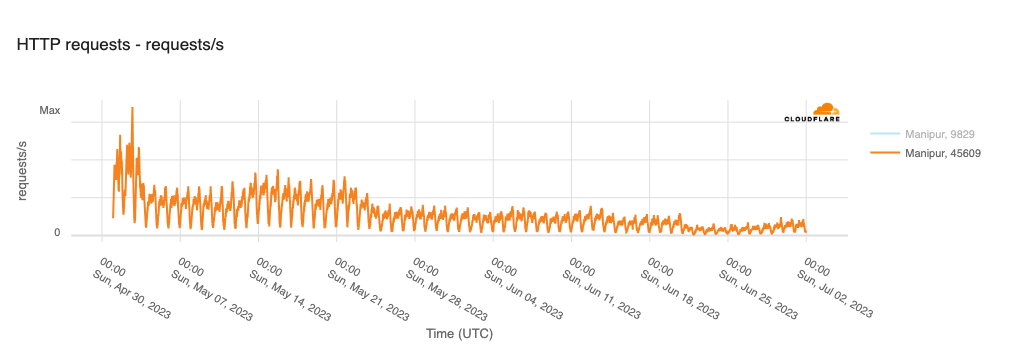
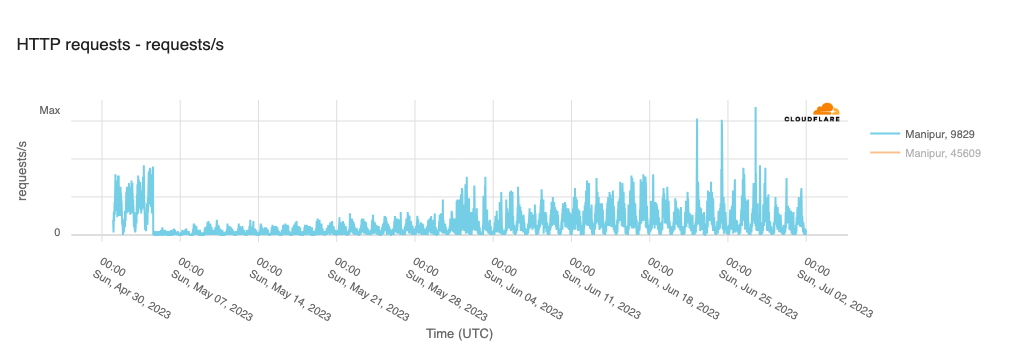
Severe weather
Guam
On May 24, “Super Typhoon” Mawar wreaked havoc on the US territory of Guam, causing widespread physical damage after it made landfall, taking down trees, buildings, power lines, and communications infrastructure across the island. One result of this damage was a significant disruption to Internet connectivity, as shown in the country-level graph below. Restoration efforts started almost immediately, with Guam Power Authority, Docomo Pacific, and GTA Teleguam all posting regular status updates on their websites and/or social media accounts.
Among the two Internet providers, GTA Teleguam (AS9246) was largely able to complete service restoration in June, with traffic returning to pre-storm levels around June 17, as seen in the graph below. In fact, in a June 20 Facebook post they noted that “As of today, a majority of our wireless network cell sites are operational.” However, recovery at Docomo Pacific (AS3605) is taking significantly longer. The graph below shows that as of the end of June, traffic remained significantly below pre-storm levels.
Cable damage
Bolivia
On June 19, COTAS, a Bolivian telecommunications company, posted an update on their Facebook page that alerted users that a fiber optic cable had been cut in the town of Pongo. As seen in the graphs below, this cut significantly disrupted Internet connectivity across COTAS and two other network providers in the country: AS25620 (COTAS), AS27839 (Comteco), and AS52495 (Cotel) between 13:00 - 18:00 local time (17:00 - 22:00 UTC).
The Gambia
Gamtel, the state telecommunications company in The Gambia, notified subscribers via a Twitter post on June 7 of a localized fiber cut, and then of additional cable cuts on June 8. These fiber cuts disrupted Internet connectivity on AS25250 (Gamtel) between 14:00 local time on June 7 and 00:00 local time on June 9, with traffic volumes down as much as 80% as compared to the previous period. (The Gambia is UTC+0, so the local times are the same as UTC.)
Philippines
An advisory posted on Twitter by Philippines telecommunications provider PLDT at 18:43 local time (10:43 UTC) on June 5 stated “One of our submarine cable partners confirms a loss in some of its internet bandwidth capacity, and thus causing slower Internet browsing. We are working with our partners to provide alternate capacity that would restore the browsing experience in the next few hours.” The traffic graph below shows a minor disruption to Internet traffic for AS9299 (PLDT) starting around 14:00 local time (06:00 UTC), and the “slower Internet browsing” noted by PLDT is evident in the Internet quality graphs below, with increased latency and decreased bandwidth evident around that same time. PLDT stated in a subsequent tweet that as of 06:22 local time on June 6 (22:22 UTC on June 5), “Our submarine cable partner confirms supplementing additional capacity, restoring browser experience.”
Power outages
Curaçao
Aqualectra is the primary utility company in Curaçao, providing water and power services. On June 8, they posted a series of alerts to their Facebook page (1, 2, 3, 4) regarding a power outage impacting “all neighborhoods”, caused by a malfunction in one of the main power cables connected to the substation at Parera. This loss of power impacted Internet connectivity on the island, with a significant loss of traffic observed at a country level, as seen in the graph below, as well as across several Internet service providers, including AS11081 (UTS), AS52233 (Columbus Communications), and AS27660 (Curaçao Telecom). A followup Facebook post dated 01:25 local time on June 9 (05:25 UTC) confirmed the restoration of power to all neighborhoods.
Portugal
A power outage at an Equinix data center in Prior Velho (near Lisbon) on the afternoon of June 6 affected local utilities, banking services, and court networks, according to published reports (1, 2). Portuguese Internet service provider MEO was also impacted by the power outage, which caused a drop in traffic for AS3243 (MEO-RESIDENCIAL) and AS15525 (MEO-EMPRESAS), seen in the graphs below. The disruptions caused by the power outage also impacted connectivity quality within Portugal, as the Radar Internet quality graphs below highlight – a concurrent drop in bandwidth and increase in latency is visible, indicating that end users likely experienced poorer performance during that period of time.
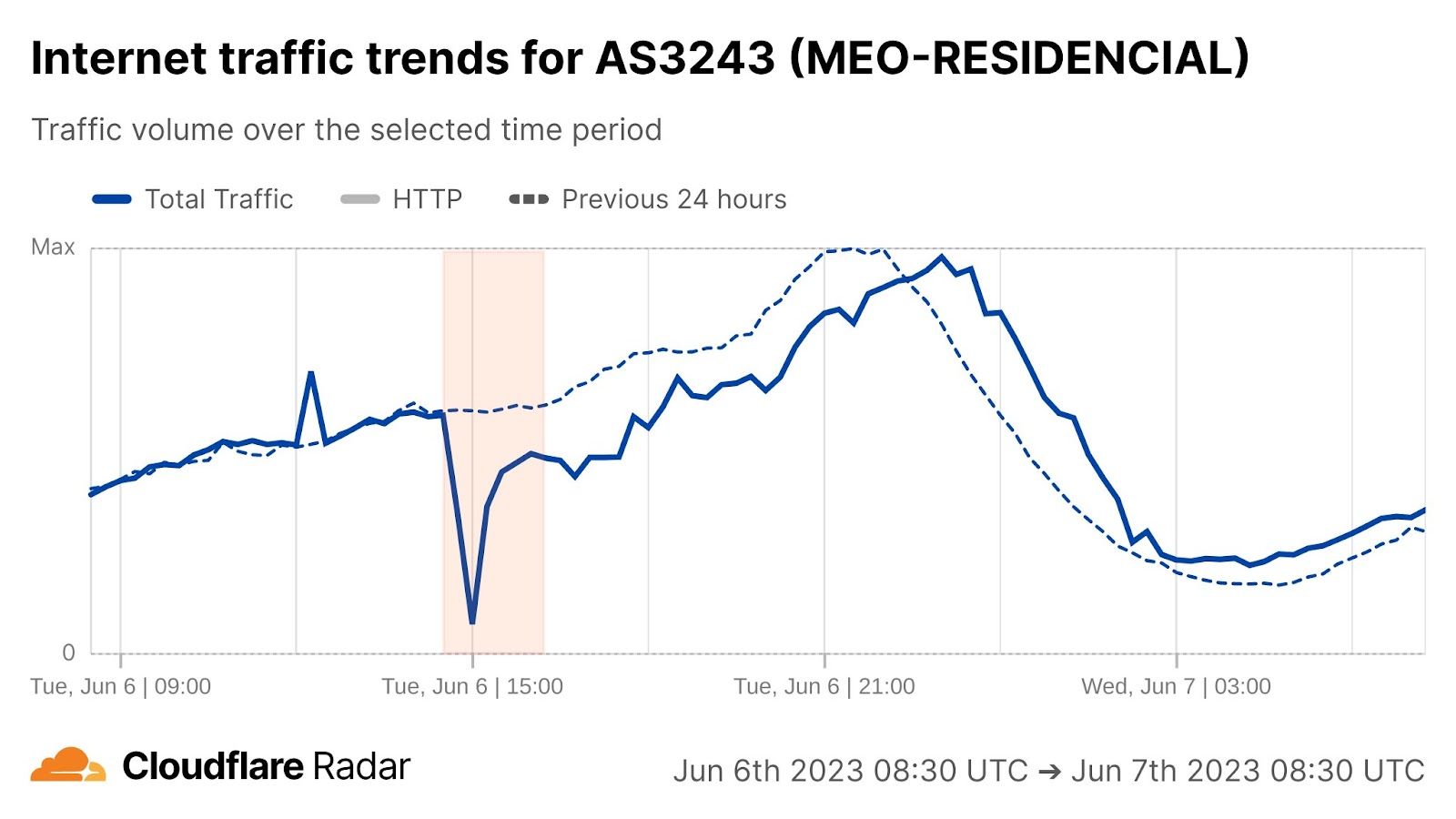
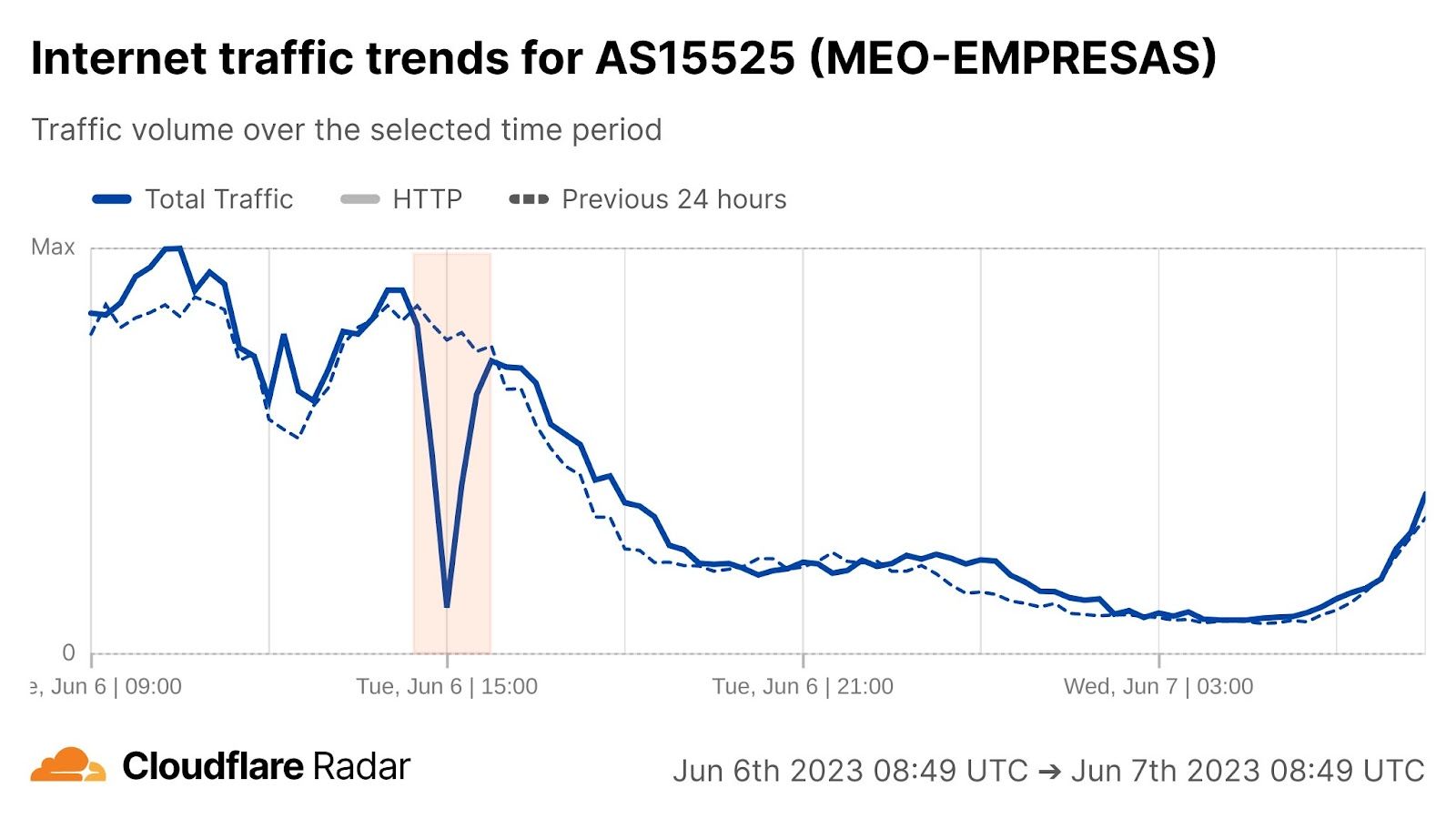
Botswana
A countrywide power outage in Botswana on May 19 caused an Internet disruption that lasted about 90 minutes, from 10:45 until 12:15 local time (08:45 - 10:15 UTC), visible in the graph below. A tweet from Botswana Power Corporation provided public notice of the incident, but did not include a root cause.
Barbados
On April 4, The Barbados Light & Power Company tweeted an “Outage Notice”, stating “We are aware that our customers across the island are currently without electricity.” Posted at 11:46 local time (15:46 UTC), the notice comes shortly after a significant drop in traffic was observed country-wide, indicating that the power outage also impacted Internet connectivity across the country. After posting several additional updates throughout the day, a final update posted at 18:00 local time (22:00 UTC) indicated that power had been restored to 100% of impacted customers. The graph below shows that traffic took several additional hours to return to normal levels. (Note that the orange highlighting in the graph represents the duration of the disruption, and the red shading is related to an internal data collection issue.)
Technical problems
Namibia
A seven-hour Internet disruption observed in Namibia on June 15 and 16 was caused by unspecified “technical challenges” faced by Telecom Namibia. According to a tweet from the provider, “Telecom Namibia experienced technical challenges on its fixed and mobile data services on Thursday leading to intermittent Internet connectivity.” The impact of these challenges is visible in both the country- and network-level traffic graphs below.
Solomon Islands
Unspecified “technical reasons” also disrupted mobile Internet connectivity for Our Telekom customers in the Solomon Islands on April 26 and 27. An April 26 Facebook post from Our Telekom simply stated “Our mobile data network is currently down due to technical reasons.” The graphs below show a significant drop in traffic for AS45891 (Our Telekom/SBT) between 06:30 local time on April 27 (19:30 UTC on April 26) and 17:00 local time on April 27 (06:00 UTC). The loss of mobile traffic from Our Telekom also impacted traffic at a country level, as the graph shows a similar disruption for the Solomon Islands.
SpaceX Starlink
With an increasingly global service footprint, disruptions observed on SpaceX Starlink potentially impact users across multiple countries around the world. Just before midnight UTC on April 7, Internet traffic seen from AS14593 (SpaceX-Starlink) began to decline significantly. The disruption was short-lived, with traffic returning to expected levels within two hours. According to a Twitter post from Elon Musk, CEO of SpaceX, the problem was “Caused by expired ground station cert” (an expired digital certificate associated with one or more Starlink ground stations, likely preventing communication between the satellite constellation and the ground station(s)).
Madagascar
In Madagascar, a “problem with the backbone”, reported by Telma Madagascar, caused a loss of as much as two-thirds of Internet traffic between 09:15 - 14:00 local time (06:15 - 11:00 UTC) on April 7. The graphs below show that the backbone issue disrupted traffic at a national level, as well as for AS37054 (Telma Madagascar).
United Kingdom
On April 4, UK Internet provider Virgin Media suffered multiple service disruptions that impacted Internet connectivity for broadband customers. The first outage started just before 01:00 local time (midnight UTC)l, lasting until approximately 09:00 local time (08:00 UTC). The second outage started around 16:00 local time (15:00 UTC), with traffic volumes going up and down over the next several hours before appearing to stabilize around 21:30 local time (20:30 UTC).
Virgin Media’s Twitter account acknowledged the early morning disruption several hours after it began, posting “We’re aware of an issue that is affecting broadband services for Virgin Media customers as well as our contact centres. Our teams are currently working to identify and fix the problem as quickly as possible and we apologise to those customers affected.” A subsequent post after service restoration noted “We’ve restored broadband services for customers but are closely monitoring the situation as our engineers continue to investigate. We apologise for any inconvenience caused.”
However, the second disruption was acknowledged on Virgin Media’s Twitter account much more rapidly, with a post at 16:25 UTC stating “Unfortunately we have seen a repeat of an earlier issue which is causing intermittent broadband connectivity problems for some Virgin Media customers. We apologise again to those impacted, our teams are continuing to work flat out to find the root cause of the problem and fix it.”
Although no additional details have been shared via social media by Virgin Media about the outages or their resolution, some additional information was shared via Twitter by an apparent customer, who posted “Virgin Media engineers re-seated fibre cards and reset hub equipment to restore service. TTL was extended as a workaround to maintain stability whilst a permanent fix is implemented.”
Additional details about the Virgin Media outage can be found in our April 4 blog post: Cloudflare’s view of the Virgin Media outage in the UK.
Cyberattacks
Ukraine
As we have covered in past blog posts, the physical war between Russia and Ukraine also has a very active online component, with traffic shifts, cyberattacks, and traffic rerouting all observed since the conflict began in February 2022. In early May 2022, we observed traffic from several Ukrainian network providers being rerouted through AS201776 (Miranda Media), a Crimean-based, Russian-controlled network operator. (This rerouting is discussed in more detail in two blog posts: Tracking shifts in Internet connectivity in Kherson, Ukraine and One year of war in Ukraine: Internet trends, attacks, and resilience.)
A little more than a year later, on May 26, we observed an Internet outage at Miranda Media. Traffic started to fall around 16:30 local time (13:30 UTC), dropping to zero around 18:15 local time (15:15 UTC). The outage disrupted connectivity on the Crimean Peninsula and parts of occupied Ukraine and lasted until approximately 06:00 local time on May 27 (03:00 UTC). Published reports (1,2) suggest that the outage was due to a cyberattack targeting Miranda Media, reportedly carried out by Ukrainian hacktivists.
Russia
Russian satellite provider Dozor Teleport, whose customers include Russia’s Ministry of Defense, ships of the Northern Fleet, Russian energy firm Gazprom, remote oil fields, the Bilibino nuclear power plant, the Federal Security Service (FSB), Rosatom, and other organizations, experienced a multi-hour outage on June 29. The outage, which occurred between 01:30 - 17:30 UTC, was reportedly the result of a cyberattack that at least two groups claimed responsibility for.
Military action
Chad
Multiple Internet disruptions occurred in Chad on April 23 and 24, impacting several Internet providers, and were ultimately visible at a country level as well. As seen in the graphs below, the outages occurred from 04:30 - 06:00 local time (03:30 - 05:00 UTC) and 15:00 - 20:00 local time (14:00 - 19:00 UTC) on April 23, and 04:00 - 08:30 local time (03:00 - 07:30 UTC) on April 24. The impacted network providers in Chad included AS327802 (Millicom Chad), AS327756 (Airtel Chad), AS328594 (Sudat Chad), and AS327975 (ILNET-TELECOM). The outages were reportedly caused by damage to fiber infrastructure that links Chad with neighboring Cameroon and Sudan, with the latter experiencing Internet service disruptions amid clashes between the Sudanese Armed Forces (SAF) and Rapid Support Forces (RSF).
Sudan
As noted above, military action in Sudan disrupted Internet connectivity in Chad in April. Starting in mid-April, multiple Internet outages were observed at major Sudanese Internet providers, three of which are shown in the graphs below. The fighting in the country has led to fuel shortages and power cuts, ultimately disrupting Internet connectivity.
AS15706 (Sudatel) experienced complete Internet outages from 03:00 on April 23 to 17:00 on April 24 local time (01:00 on April 23 to 15:00 on April 24 UTC) and again from 03:00 on April 25 until 01:00 on April 28 local time (01:00 on April 25 to 23:00 on April 27 UTC). Internet connectivity on AS36972 (MTN) was disrupted between 03:00 and 12:00 local time on April 16 (01:00 - 10:00 UTC) and again between 20:00 on April 27 until 02:00 on April 29 (18:00 on April 27 to 00:00 on April 29). After a nominal multi-day recovery, a long-term near complete outage started on May 5, lasting for multiple weeks. Similar to MTN, multiple extended outages were also observed on AS33788 (Kanar Telecommunication). After seeing a significant drop in traffic midday on April 19, a near complete outage is visible between 12:00 on April 21 and 01:00 on April 29 (10:00 on April 21 to 23:00 on April 28 UTC), with a very brief minor recovery late in the day on April 24. A longer duration outage began around 00:00 local time on May 11 (22:00 on May 10 UTC), also lasting for multiple weeks.
Additional details about the Internet disruptions in Sudan can be found in our May 2 blog post: Effects of the conflict in Sudan on Internet patterns.
Maintenance
Togo, Republic of Congo (Brazzaville), Burkina Faso
Repair work on the West Africa Cable System (WACS) submarine cable disrupted Internet connectivity across multiple countries, including Togo, Republic of Congo (Brazzaville), and Burkina Faso on April 6. According to the Google translation of a Facebook post from Canalbox Congo, the repair work was likely to cause “very strong disruptions on Internet connections with the risk of a total outage”. (Canalbox (GVA) is an African telecommunications operator that provides services across multiple countries in Africa.)
The graph below for AS36924 (GVA-Canalbox) shows three overlapping outage annotations, with each related to a disruption observed on that autonomous system (network) in one of the impacted countries. In the Republic of Congo (Brazzaville), a significant traffic disruption is visible between 16:15 - 23:15 local time (15:15 - 22:15 UTC). In Burkina Faso, the disruption happened earlier and was less severe, taking place between 09:15 - 18:00 local time (09:15 - 18:00 UTC), with a similar impact in Togo, where traffic was disrupted between 11:00 - 23:15 local time (11:00 - 23:15 UTC).
Conclusion
Because of how tightly interwoven the Internet has become with commerce, financial services, and everyday life around the world, any disruption to Internet connectivity ultimately carries an economic impact. The providers impacted by disruptions caused by unexpected or unavoidable events such as cable cuts or severe weather generally try to minimize the scope and duration of such disruptions, ultimately limiting the economic impact. However, in the case of government-directed Internet shutdowns, the damage to the economy is ultimately self-inflicted. The Internet Society’s new Net Loss Calculator now provides a way to quantify this damage, enabling the public, advocacy groups, and governments themselves to understand the potential cost of an Internet shutdown from gross domestic product (GDP), foreign direct investment (FDI), and unemployment perspectives.
Visit Cloudflare Radar for additional insights around Internet disruptions. Follow us on social media at @CloudflareRadar (Twitter), cloudflare.social/@radar (Mastodon), and radar.cloudflare.com (Bluesky), or contact us via email.
We protect entire corporate networks, help customers build Internet-scale applications efficiently, accelerate any website or Internet application, ward off DDoS attacks, keep hackers at bay, and can help you on your journey to Zero Trust.
Visit 1.1.1.1 from any device to get started with our free app that makes your Internet faster and safer.
To learn more about our mission to help build a better Internet, start here. If you're looking for a new career direction, check out our open positions.
